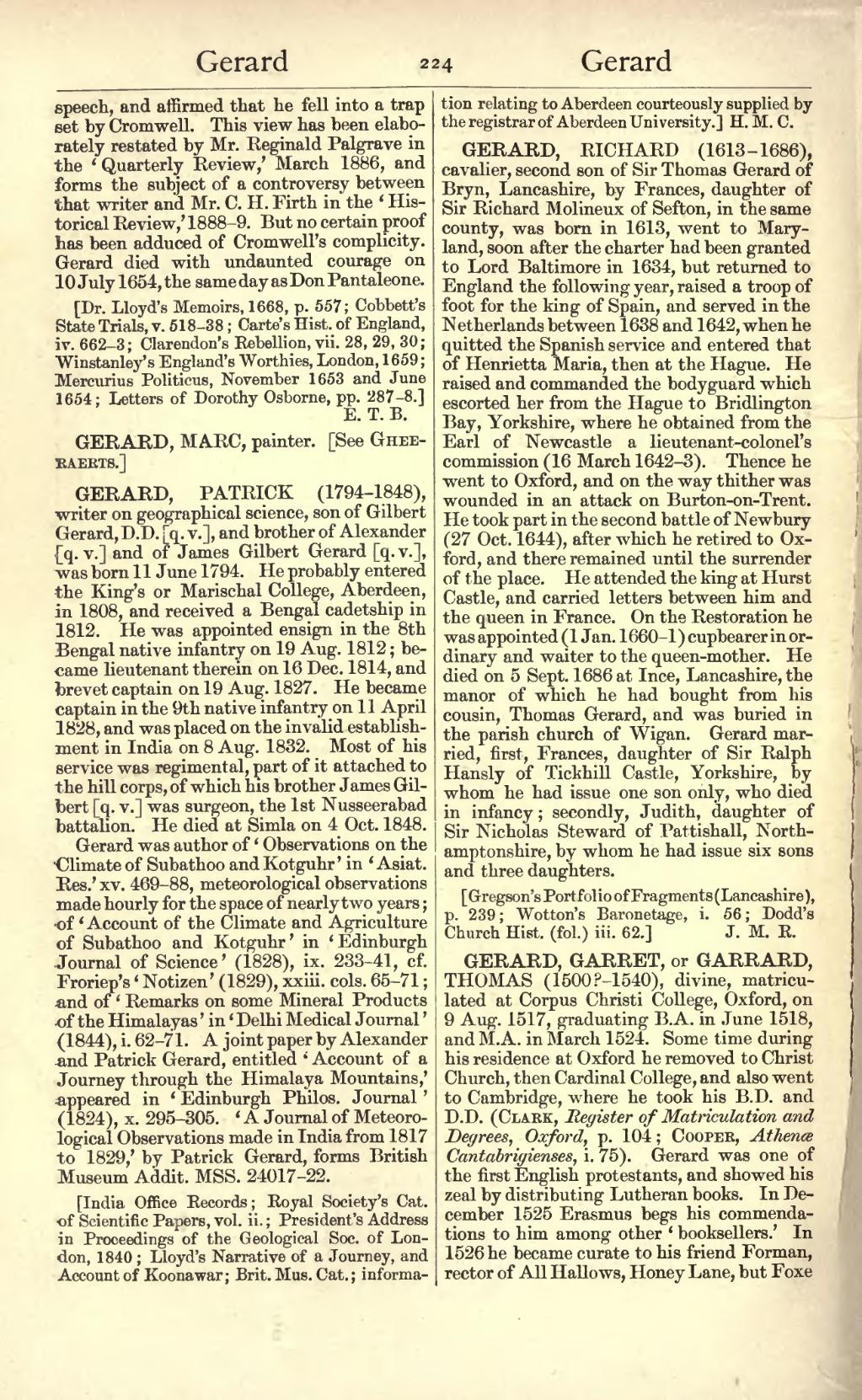speech, and affirmed that he fell into a trap set by Cromwell. This view has been elaborately restated by Mr. Reginald Palgrave in the ‘English Historical Review’ for October 1888, in the course of a controversy between that writer and Mr. C. H. Firth. But no certain proof has been adduced of Cromwell's complicity. Gerard died with undaunted courage on 10 July 1654, the same day as Don Pantaleone.
[Dr. Lloyd's Memoirs, 1668, p. 557; Cobbett's State Trials, v. 518–38; Carte's Hist. of England, iv. 662–3; Clarendon's Rebellion, vii. 28, 29, 30; Winstanley's England's Worthies, London, 1659; Mercurius Politicus, November 1653 and June 1654; Letters of Dorothy Osborne, pp. 287–8.]
GERARD, MARC, painter. [See Gheeraerts.]
GERARD, PATRICK (1794–1848), writer on geographical science, son of Gilbert Gerard, D.D. [q. v.], and brother of Alexander [q. v.] and of James Gilbert Gerard [q. v.], was born 11 June 1794. He probably entered the King's or Marischal College, Aberdeen, in 1808, and received a Bengal cadetship in 1812. He was appointed ensign in the 8th Bengal native infantry on 19 Aug. 1812; became lieutenant therein on 16 Dec. 1814, and brevet captain on 19 Aug. 1827. He became captain in the 9th native infantry on 11 April 1828, and was placed on the invalid establishment in India on 8 Aug. 1832. Most of his service was regimental, part of it attached to the hill corps, of which his brother James Gilbert [q. v.] was surgeon, the 1st Nusseerabad battalion. He died at Simla on 4 Oct. 1848.
Gerard was author of ‘Observations on the Climate of Subathoo and Kotguhr’ in ‘Asiat. Res.’ xv. 469–88, meteorological observations made hourly for the space of nearly two years; of ‘Account of the Climate and Agriculture of Subathoo and Kotguhr’ in ‘Edinburgh Journal of Science’ (1828), ix. 233–41, cf. Froriep's ‘Notizen’ (1829), xxiii. cols. 65–71; and of ‘Remarks on some Mineral Products of the Himalayas’ in ‘Delhi Medical Journal’ (1844), i. 62–71. A joint paper by Alexander and Patrick Gerard, entitled ‘Account of a Journey through the Himalaya Mountains,’ appeared in ‘Edinburgh Philos. Journal’ (1824), x. 295–305. ‘A Journal of Meteorological Observations made in India from 1817 to 1829,’ by Patrick Gerard, forms British Museum Addit. MSS. 24017–22.
[India Office Records; Royal Society's Cat. of Scientific Papers, vol. ii.; President's Address in Proceedings of the Geological Soc. of London, 1840; Lloyd's Narrative of a Journey, and Account of Koonawar, Brit. Mus. Cat.; information relating to Aberdeen courteously supplied by the registrar of Aberdeen University.]
GERARD, RICHARD (1613–1686), cavalier, second son of Sir Thomas Gerard of Bryn, Lancashire, by Frances, daughter of Sir Richard Molineux of Sefton, in the same county, was born in 1613, went to Maryland, soon after the charter had been granted to Lord Baltimore in 1634, but returned to England the following year, raised a troop of foot for the king of Spain, and served in the Netherlands between 1638 and 1642, when he quitted the Spanish service and entered that of Henrietta Maria, then at the Hague. He raised and commanded the bodyguard which escorted her from the Hague to Bridlington Bay, Yorkshire, where he obtained from the Earl of Newcastle a lieutenant-colonel's commission (16 March 1642–3). Thence he went to Oxford, and on the way thither was wounded in an attack on Burton-on-Trent. He took part in the second battle of Newbury (27 Oct. 1644), after which he retired to Oxford, and there remained until the surrender of the place. He attended the king at Hurst Castle, and carried letters between him and the queen in France. On the Restoration he was appointed (1 Jan. 1660–1) cupbearer in ordinary and waiter to the queen-mother. He died on 5 Sept. 1686 at Ince, Lancashire, the manor of which he had bought from his cousin, Thomas Gerard, and was buried in the parish church of Wigan. Gerard married, first, Frances, daughter of Sir Ralph Hansby of Tickhill Castle, Yorkshire, by whom he had issue one son only, who died in infancy; secondly, Judith, daughter of Sir Nicholas Steward of Pattishall, Northamptonshire, by whom he had issue six sons and three daughters.
[Gregson's Portfolio of Fragments (Lancashire), p. 239; Wotton's Baronetage, i. 56; Dodd's Church Hist. (fol.) iii. 62.]
GERARD, GARRET, or GARRARD, THOMAS (1500?–1540), divine, matriculated at Corpus Christi College, Oxford, on 9 Aug. 1517, graduating B.A. in June 1518, and M.A. in March 1524. Some time during his residence at Oxford he removed to Christ Church, then Cardinal College, and also went to Cambridge, where he took his B.D. and D.D. (Clark, Register of Matriculation and Degrees, Oxford, p. 104; Cooper, Athenæ Cantabrigienses, i. 75). Gerard was one of the first English protestants, and showed his zeal by distributing Lutheran books. In December 1525 Erasmus begs his commendations to him among other ‘booksellers.’ In 1526 he became curate to his friend Forman, rector of All Hallows, Honey Lane, but Foxe
